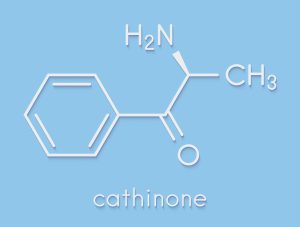What are Bath Salts?
Artificial cathinones, more commonly called “bath salts,” are artificial (human-made) drugs chemically related to cathinone, a stimulant found in the khat plant. Khat is a shrub grown in East Africa and southern Arabia, and people occasionally chew its leaves due to their mild stimulant effects. Artificial variations of cathinone can be a lot stronger than the natural product and, sometimes, very dangerous
Artificial cathinones are contained in a group of medications that concern public health officials known as “new psychoactive substances” (NPS). NPS are unregulated psychoactive (mind-altering) substances which have become newly available in the marketplace and are meant to replicate the effects of illegal drugs. Some of these substances might have existed for decades but have reentered the market in modified chemical forms or because of renewed popularity.
In Name Only
Artificial cathinone products marketed as “bath salts” shouldn’t be confused with products like Epsom salts that people use during bathing. These bathing products don’t have any mind-altering ingredients.
Artificial cathinones are marketed as cheap substitutes for other stimulants such as methamphetamine and cocaine, and goods marketed as Molly (MDMA) often contain synthetic cathinones rather
Artificial cathinones usually take the form of a white or brownish crystal-like powder and are sold in plastic or foil packs labeled “not for human consumption.” Also sometimes labeled as “plant food,” “jewelry cleaner,” or “phone screen cleaner,” people can purchase them online and in drug paraphernalia shops under many different brand names, including:-
- Flakka
- Bloom
- Cloud Nine
- Lunar Wave
- Vanilla Sky
- White Dragon
- Scarface
How do people use synthetic cathinones?
 People typically consume, snort, smoke, or inject artificial cathinones.
People typically consume, snort, smoke, or inject artificial cathinones.
How can artificial cathinones influence the brain?
Much remains unknown about how artificial cathinones influence the human brain. Researchers do know that artificial cathinones are chemically similar to amphetamines, cocaine, and MDMA. These medications can cause a variety of effects such as lowered inhibition, anxiety, and depression. Read more about amphetamines, cocaine, and MDMA:-
Individuals who have taken synthetic cathinones have reported energizing and frequently agitating effects. Synthetic cathinones may also raise heart rate and blood pressure. A recent study found that 3,4-methylenedioxypyrovalerone (MDPV), a common synthetic cathinone, affects the brain in a fashion similar to cocaine but is at least 10 times stronger. | MDPV is the most popular artificial cathinone found in the blood and urine of patients admitted to emergency departments after taking “bath salts” (Baumann et al., 2013).|
Artificial cathinones can create effects which have:-
- paranoia–intense and irrational distrust of others
- hallucinations–experiencing sensations and images that appear real though they’re not
- increased sociability
- increased sex drive
- panic attacks
- excited delirium–intense agitation and violent behaviour
What are other health effects of artificial cathinones?
Nosebleeds, sweating, and nausea are several other health effects of artificial cathinones. Individuals who undergo excited delirium often suffer from dehydration, breakdown of skeletal muscle tissue, and kidney failure.|
Intoxication from artificial cathinones has led to death. The worst results are associated with snorting or needle injection.
Artificial Cathinones and Molly
Molly–slang for “molecular,” refers to the pure crystal form of 3,4-methylenedioxymetamphetamine(MDMA). | Usually purchased in capsules, Molly is becoming popular in the last couple of years. Users might be looking for Molly to prevent the additives commonly found in MDMA pills sold as Ecstasy, such as caffeine, methamphetamine, and other dangerous drugs. But people who take what they believe is “pure” Molly might be exposing themselves to the exact risks. News stories have reported Molly capsules containing harmful compounds which include synthetic cathinones. By way of instance, countless Molly capsules analyzed in two South Florida crime labs in 2012 contained methylone, a harmful synthetic cathinone.
Are artificial cathinones addictive?
Yes, synthetic cathinones could be addictive. Animal studies show that rats will compulsively self-administer artificial cathinones. Individual users have reported that the medication activate extreme cravings–uncontrollable urges to use the drug again. Taking synthetic cathinones frequently may cause strong withdrawal symptoms which have:-
- melancholy
- anxiety
- tremors
- problems sleeping
- paranoia
How do people get treatment for dependence on synthetic cathinones?
Behavioral therapy can be used as a treatment for addiction to artificial cathinones. Examples include:-
- cognitive-behavioral therapy
- contingency management, or motivational incentives–providing benefits to patients that remain chemical free
- motivational enhancement therapy
- behavioral treatments geared to adolescents
No drugs are currently available to treat addiction to synthetic cathinones.